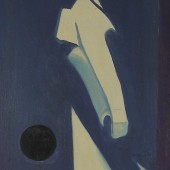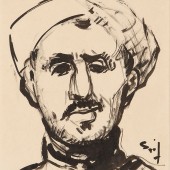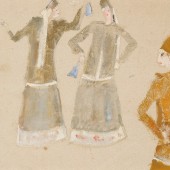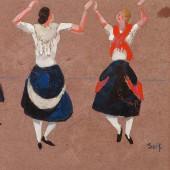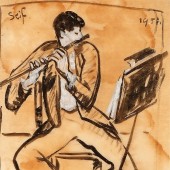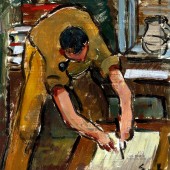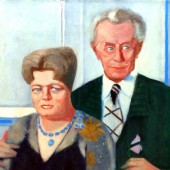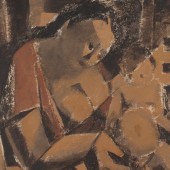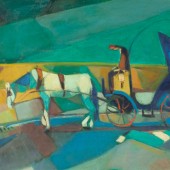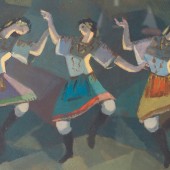Seif Wanly
Employing a distinct style of bright colours, form and composition, the paintings of Seif Wanly blend the geometry of simplified shapes with Futurist and Cubist influences.
Born in Alexandria into an aristocratic Egyptian family, Wanly was privately tutored in art. In his portraits we find characters in self- reflective gestures detached from the pace of life. While some of his paintings capture live entertainment, theatre and musical performances such as travelling circuses and ballets, as seen in Russian Ballet (1958-60), Wanly’s primary concentration was to depict daily life. In Mother and Child (1957), he explores maternal intimacy, while Nocturne (1953) features a reflective scene of a solitary driver dozing on his a horse drawn taxi.
The artist established an art studio in Alexandria in the 1940s with his brother Adham Wanly that was open to the public and any-one interested in the arts. In the late 1950s, Wanly travelled to Nubia to produce a series of paintings and drawings portraying life in Upper Egypt for a governmental project to document culture and conditions prior to the relocation that occurred to enable construction of the Aswan High Dam.
Related artists by country
- Ahmed Askalany
- Adam Henein
- Chant Avedissian
- Fathi Afifi
- Fathi Hassan
- George Bahgory
- Ghada Amer
- Huda Lutfi
- Khaled Hafez
- Lara Baladi
- Abdel Hadi El Gazzar
- Ahmed Moustafa
- Raafat Ishak
- Susan Hefuna
- Youssef Nabil
- Gazbia Sirry
- Ragheb Ayad
- Samir Rafi
- Omar El Nagdi
- Hamed Nada
- Kamel Moustafa
- Kareem Lotfy
- Mahmoud Said
- Mohammed Naghi
- Nermine Hammam
- Youssef Kamel
- Hazem Mahdy
- Ayad Al Nimar
- Mohammed Ismail
- Adel El Siwi
- Adham Wanly
- Guirguis Lotfy
- Hussein Bicar
- Inji Efflatoun
- Kamel El Telmesani
- Khaled Zaki
- Moataz Nasr
- Reda Abdelrahman
- Shaaban Zaki
- Effat Naghi
- Farghali Abdel Hafiz
- Mohammed Sabry
- Wael Darwish
- Ahmed Kassem
- Marwa Adel
- Ammar Abo Bakr
- Basim Magdy
- Ganzeer
- Iman Issa
- Mohamed Abou El Naga
- Clea Badaro
- Farida El Gazzar
- Hamed Ewais
- Maha Maamoun
- Marguerite Nakhla
- Ramses Younan
- Salah Abdel Kerim
- Yasser Rostom
- Amr Nazeer
- Aya Tarek
- George Hanna Sabbagh
- Nadim Raef
- Tahia Halim
- Hussein Fawzi
- Ahmed Morsi
- Walid Ebeid
- Ezequiel Baroukh
- Saad El Khadem
- Van Leo
- Mamdouh Ammar
- Salah Taher
- Zeinab Abd El Hamid
- Armen Agop
- Wassef Boutros-Ghali
- Menhat Helmy
- Mariam Abdel-Aleem
- Hamed Abdalla
- Alaa Awad
- Ehsan Mokthar
- Fatma Arargi
- Salam Yousry
- Anna Boghighuian
- Gamal El Sagini
- Leila Izzat
- Mahmoud Afifi
- Nadia Mohammed
- Rebab Nemr
- Khadiga Riad
- Abdel Badie Abdel Hay
- Mahrous Abdou
- Mohamed Abla
- Nazek Hamdy
- Atyat El Ahwal
- Nitokriss
- Fahima Amin
- Kawkab Youssef Al Assal
- Etimad El Taraboulsy
- Naeema El Shishini
- Kadria Hussein
- Aida Marini
- Mohamed Elbehairy
- Ezzat Ibrahim
- Ihsan Khalil
- Salam El-Alak
- Zainab Abdo
- Maggy Axisa
